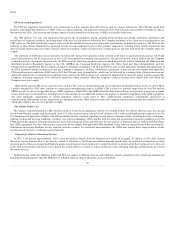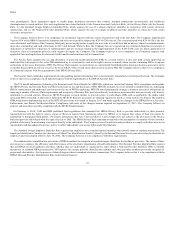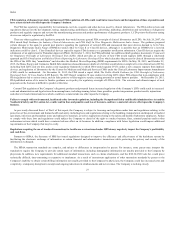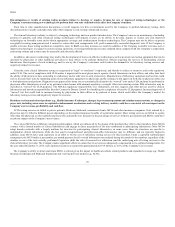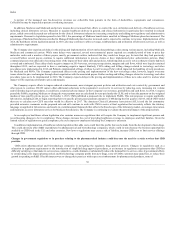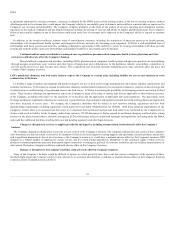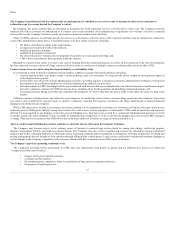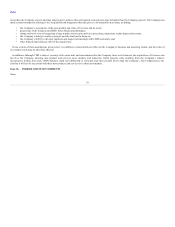LabCorp 2015 Annual Report Download - page 30
Download and view the complete annual report
Please find page 30 of the 2015 LabCorp annual report below. You can navigate through the pages in the report by either clicking on the pages listed below, or by using the keyword search tool below to find specific information within the annual report.
Index
A portion of the managed care fee-for-service revenues are collectible from patients in the form of deductibles, copayments and coinsurance.
Collectibility may be impacted as patient cost-sharing increases.
In addition, Medicare and Medicaid and private insurers have increased their efforts to control the cost, utilization and delivery of healthcare services,
including clinical laboratory services. Measures to regulate healthcare delivery in general, and clinical laboratories in particular, have resulted in reduced
prices, added costs and decreased test utilization for the clinical laboratory industry by increasing complexity and adding new regulatory and administrative
requirements. Pursuant to legislation passed in late 2003, the percentage of Medicare beneficiaries enrolled in Managed Medicare plans has increased. The
percentage of Medicaid beneficiaries enrolled in Managed Medicaid plans has also increased, and is expected to continue to increase. Implementation of the
ACA, the healthcare reform legislation passed in 2010, also may continue to affect coverage, reimbursement, and utilization of laboratory services, as well as
administrative requirements.
The Company also experienced delays in the pricing and implementation of new molecular pathology codes among various payers, including Medicaid,
Medicare and commercial carriers. While some delays were expected, several non-commercial payers required an extended period of time to price key
molecular codes and a number of those payers, mostly government entities, indicated that they would no longer pay for tests that they had previously
covered. Further, several payers continue to require additional information to process claims or have implemented prior authorization policies. Many
commercial payers were delayed in becoming aware of the impact of their claim edits and policies, which impeded access to services that previously had been
covered and reimbursed. These delays had a negative impact on 2014 revenue, revenue per requisition, margins and cash flows, which were largely sustained
throughout 2015, and are expected to have a continuing negative impact. Similarly, CLFS coding and billing changes related to toxicology and other
procedures were implemented in 2016 and Palmetto implemented a Drugs of Abuse Local Coverage Policy which impacted the handling of such procedures
for Medicaid and MCOs. The Company experienced delays in the pricing and implementation of the new toxicology codes, however, largely overcame
issues related to price and margins through direct negotiation with the associated payers. Further coding and billing changes related to toxicology and other
procedure types are to be implemented in 2016. The Company expects delays in the pricing and implementation of these new codes and it is unclear what
impact will be experienced related to price and margins.
The Company expects efforts to impose reduced reimbursement, more stringent payment policies and utilization and cost controls by government and
other payers to continue. If LCD cannot offset additional reductions in the payments it receives for its services by reducing costs, increasing test volume
and/or introducing new procedures, it could have a material adverse impact on the Company’s net revenues, profitability and cash flows. In 2014, Congress
passed the PAMA, requiring Medicare to change the way payment rates are calculated for tests paid under the CLFS, and to base the payment on the weighted
median of rates paid by private payers. On October 1, 2015, CMS published a proposed rule to implement PAMA. This rule proposes to require applicable
laboratories, including LCD, to begin reporting their test-specific private payer payment amounts to CMS during the first quarter of 2016, which CMS would
then use to calculate new CLFS rates that would be effective in 2017. The American Clinical Laboratory Association (ACLA) and the lab community
provided extensive comments on the proposed rule and will continue to work with CMS to arrive at final regulation that accurately reflects the statutory
language on applicable laboratories, and results in a reimbursement framework that reflects the broad scope of the laboratory market, encourages innovation,
and maintains access to laboratory services for Medicare beneficiaries. The Company is continuing to evaluate the potential impact of the proposed rule.
As an employer, healthcare reform legislation also contains numerous regulations that will require the Company to implement significant process and
record keeping changes to be in compliance. These changes increase the cost of providing healthcare coverage to employees and their families. Given the
limited release of regulations to guide compliance, the exact impact to employers including the Company is uncertain.
In addition, implementation of healthcare reform legislation that adds costs could limit the profits that can be made from the development of new drugs.
This could adversely affect R&D expenditures by pharmaceutical and biotechnology companies, which could in turn decrease the business opportunities
available to CDD both in the U.S. and other countries. New laws or regulations may create a risk of liability, increase CDD costs or limit service offerings
through CDD.
CDD assists pharmaceutical and biotechnology companies in navigating the regulatory drug approval process. Changes in regulations such as a
relaxation in regulatory requirements or the introduction of simplified drug approval procedures, or an increase in regulatory requirements that CDD has
difficulty satisfying or that make its services less competitive, could eliminate or substantially reduce the demand for its services. Also, if government efforts
to contain drug costs impact pharmaceutical and biotechnology company profits from new drugs, some of CDD’s customers may spend less, or reduce their
growth in spending on R&D. If health insurers were to change their practices with respect to reimbursement for pharmaceutical products, some of
30


